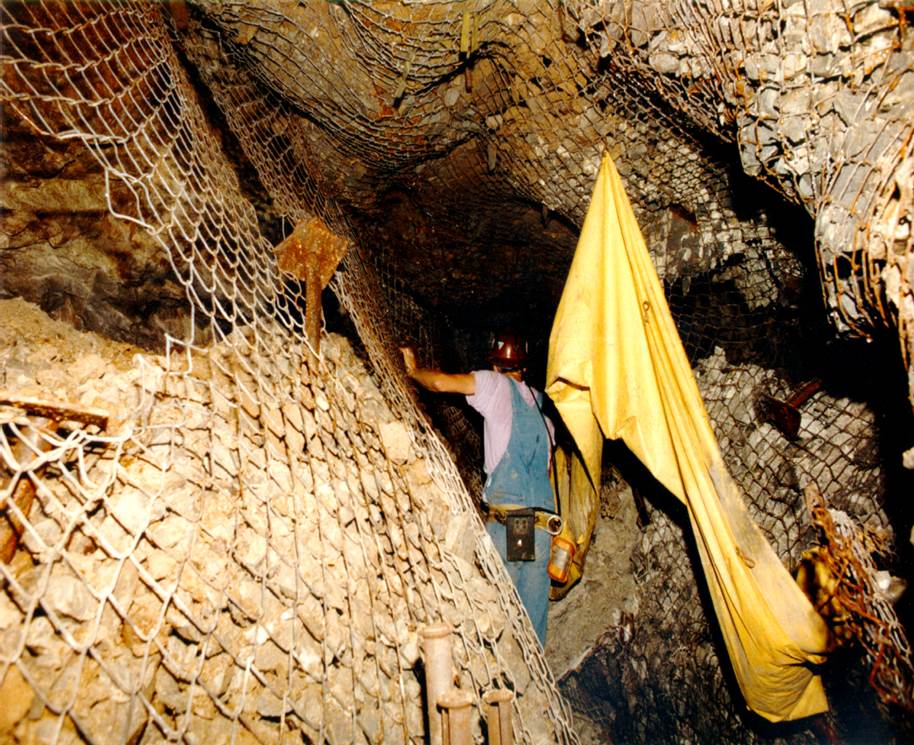Rockburst on:
[Wikipedia]
[Google]
[Amazon]
 A rock burst is a spontaneous, violent failure of
A rock burst is a spontaneous, violent failure of
 A rock burst is a spontaneous, violent failure of
A rock burst is a spontaneous, violent failure of rock
Rock most often refers to:
* Rock (geology), a naturally occurring solid aggregate of minerals or mineraloids
* Rock music, a genre of popular music
Rock or Rocks may also refer to:
Places United Kingdom
* Rock, Caerphilly, a location in Wale ...
that can occur in high-stress mines. Although mines may experience many mining-related seismic events, only the tremors associated with damage to accessible mine workings are classified as rock bursts. The opening of mine workings relieves neighboring rocks of tremendous pressure, which can cause the rock to fail explosively or trigger abrupt movement in nearby geological structures. Rock bursts are a serious hazard;
Always a problem in South Africa
South Africa, officially the Republic of South Africa (RSA), is the Southern Africa, southernmost country in Africa. Its Provinces of South Africa, nine provinces are bounded to the south by of coastline that stretches along the Atlantic O ...
, they kill a large number of miners each year.
Details
Rock bursts result from brittle fracturing of rock, causing it to collapse rapidly with violentspall
Spall are fragments of a material that are broken off a larger solid body. It can be produced by a variety of mechanisms, including as a result of projectile impact, corrosion, weathering, cavitation, or excessive rolling pressure (as in a ba ...
ing of rock that is approximately 100 to 200 tonnes, or more. This release of energy reduces the potential energy of the rock around the excavation. Another explanation is that the changes brought about by the mine's redistribution of stress trigger latent seismic events, deriving from the strain energy produced by its geological aspects.
The likelihood of rock bursts occurring increases as the depth of the mine increases. Rock bursts are also affected by the size of the excavation (the larger the more risky), becoming more likely if the excavation size is around 180 m and above. Induced seismicity
Induced seismicity is typically earthquakes and tremors that are caused by human activity that alters the stresses and strains on Earth's crust. Most induced seismicity is of a low magnitude. A few sites regularly have larger quakes, such as The ...
such as faulty methods of mining can trigger rock bursts. Other causes of rock bursts are the presence of faults, dykes, or joints
A joint or articulation (or articular surface) is the connection made between bones, ossicles, or other hard structures in the body which link an animal's skeletal system into a functional whole.Saladin, Ken. Anatomy & Physiology. 7th ed. McGraw- ...
.
Mitigation
Approaches for dealing with rock bursts can be divided into two categories: tactical measures, which can be taken locally and at short notice in response to a heightened level of rock burst hazard, and strategic measures, which must be integrated into the mine design process and long-term planning.Tactical measures
A number of tactical measures have been used successfully to reduce rockburst hazards. They include: # Using support systems that absorb energy and deform without breaking. Even where these systems suffer damage, they are often able to limit falls of ground and permit access where other systems fail completely. # Using destress blasting can reduce rock burst hazards, particularly highly stressed brittle rock. Destress holes can be efficiently integrated into conventional rounds. Destress blasting of large volumes, however, can be more problematic. # Slowing the rate of extraction will often reduce the amount of seismicity in relation to tonnage mined and may actually prevent bursting under some conditions.Strategic measures
Strategic measures that have been used successfully include: # A properly planned sequence ofstoping
Stoping is the process of extracting the desired ore or other mineral from an underground mine, leaving behind an open space known as a stope. Stoping is used when the country rock is sufficiently strong not to collapse into the stope, althou ...
for the whole ore body should be adopted and followed as closely as possible.
# The merging of large excavations at depth should be avoided.
# Pillars, or volumes of rock in between excavations, should be eliminated or reduced to a minimum.
# Parallel veins
Veins () are blood vessels in the circulatory system of humans and most other animals that carry blood towards the heart. Most veins carry deoxygenated blood from the tissues back to the heart; exceptions are those of the pulmonary and fetal c ...
should be stoped singly, the hanging wall vein first (footwall vein first if underhand mining).
# Where veins branch, stoping should begin at the intersection and then progress away from the intersection one branch at a time.
# Where possible, stoping should proceed away from a fault or other plane of weakness.
# Mined-out areas should be filled, and filling should proceed concurrently with extraction and be kept as close to the face as possible.
See also
*Outburst (mining)
An outburst is the sudden and violent ejection of coal, rock, and gas from a coal face and surrounding strata in an underground coal mine. Outbursts can be a very serious events, possibly even resulting in fatalities.
Effects of outbursts
Outbur ...
*Coal mine bump
A coal mine bump (a bump, a mine bump, a mountain bump, or a rock burst) is a seismic jolt occurring within an underground mine due to the explosive collapse of one or more support pillars.
In room and pillar mining, tunnels are advanced in a re ...
References
Further reading
* * * * {{Authority control Mine safety Economic geology